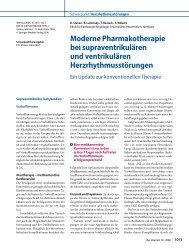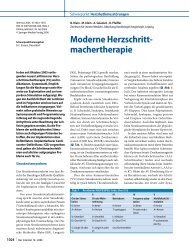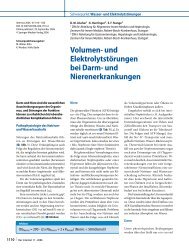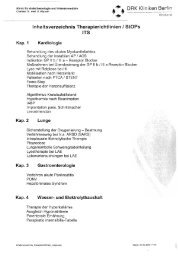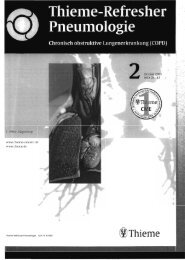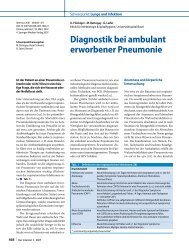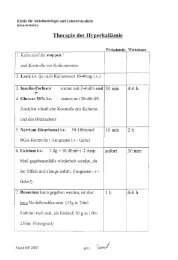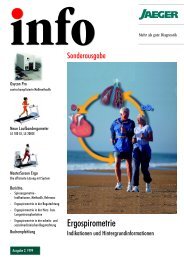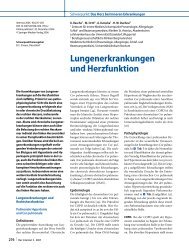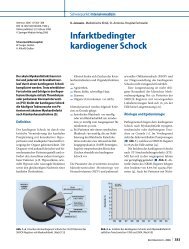Erweiterte Lebensrettende Maßnahmen - Erkan Arslan
Erweiterte Lebensrettende Maßnahmen - Erkan Arslan
Erweiterte Lebensrettende Maßnahmen - Erkan Arslan
Sie wollen auch ein ePaper? Erhöhen Sie die Reichweite Ihrer Titel.
YUMPU macht aus Druck-PDFs automatisch weboptimierte ePaper, die Google liebt.
Kapitel 4 Versorgung des Kreislaufstillstands im Krankenhaus<br />
Zusammenfassung<br />
• Der genaue Handlungsablauf einer<br />
Wiederbelebung im Krankenhaus hängt vom<br />
Ort, den Fähigkeiten des Ersthelfers, der Anzahl<br />
der Ersthelfer, dem vorhandenen Material und<br />
der Art der Organisation des Krankenhauses in<br />
Hinblick auf Notfälle und Wiederbelebung ab.<br />
• Die Sicherheit des Wiederbelebungs-<br />
Teams hat oberste Priorität während jedes<br />
Wiederbelebungs-Versuchs.<br />
• Vermeiden Sie jede unnötige Unterbrechung der<br />
Herz-Druck-Massage.<br />
Weiterführende Literatur<br />
IInternational Liaison Committee on Resuscitation. Part 4. Advanced<br />
Life Support. 2005 International Consensus on Cardiopulmonary<br />
Resuscitation and Emergency Cardiovascular Care Science with<br />
Treatment Recommendations. Resuscitation 2005;67:213-47.<br />
Nolan JP, Deakin CD, Soar J, Bottiger BW, Smith G. European<br />
Resuscitation Council Guidelines for Resuscitation 2005 Section 4: Adult<br />
advanced life support. Resuscitation 2005; 67 Suppl 1:S39-86.<br />
Abella BS, Alvarado JP, Myklebust H, et al. Quality of cardiopulmonary<br />
resuscitation during in-hospital cardiac arrest. JAMA 2005;293:305-10.<br />
Gabbott D, Smith G, Mitchell S, et al. Cardiopulmonary resuscitation<br />
standards for clinical practice and training in the UK. Resuscitation<br />
2005;64:13-9.<br />
Guidance for safer handling during resuscitation in hospitals. July 2001.<br />
Resuscitation Council UK.<br />
Perkins GD, Stephenson B, Hulme J, Monsieurs KG. Birmingham<br />
assessment of breathing study (BABS). Resuscitation 2005;64:109-13.<br />
Ruppert M, Reith MW, Widmann JH, et al. Checking for breathing:<br />
evaluation of the diagnostic capability of emergency medical services<br />
personnel, physicians, medical students, and medical laypersons. Ann<br />
Emerg Med 1999;34:720-9.<br />
Handley AJ. Teaching hand placement for chest compression—a simpler<br />
technique. Resuscitation 2002;53:29-36.<br />
Heilman KM, Muschenheim C. Primary cutaneous tuberculosis resulting<br />
from mouth-to-mouth respiration. N Engl J Med 1965;273:1035-6.<br />
Christian MD, Loutfy M, McDonald LC, et al. Possible SARS coronavirus<br />
transmission during cardiopulmonary resuscitation. Emerg Infect Dis<br />
2004;10:287-93.<br />
Cydulka RK, Connor PJ, Myers TF, Pavza G, Parker M. Prevention of oral<br />
bacterial flora transmission by using mouth-to-mask ventilation during<br />
CPR. J Emerg Med 991;9:317-21.<br />
Kern KB, Sanders AB, Raife J, Milander MM, Otto CW, Ewy GA. A study<br />
of chest compression rates during cardiopulmonary resuscitation in<br />
humans: the importanceof rate-directed chest compressions. Arch<br />
Intern Med 1992;152:145-9.<br />
34 <strong>Erweiterte</strong> <strong>Lebensrettende</strong> <strong>Maßnahmen</strong><br />
European Resuscitation Council



